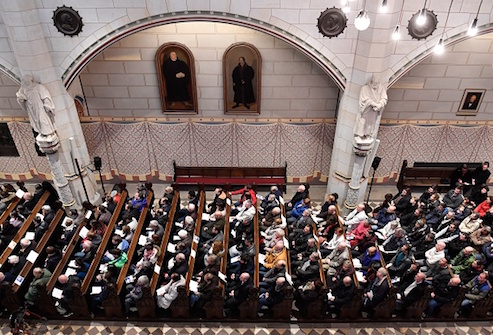A recently published paper suggests drops in religiosity are confined to the "moderately" religious, while America's strongly religious stay as firmly dedicated to their beliefs as ever.
Social theorists have in recent years argued for a so-called "secularization thesis"—as technology and science have advanced, religiosity in the western world has declined. Proponents of this view point to declines in average church attendance, self-reported religiosity, and other heuristics.
However, this focus on average decline in religiosity masks the persistence of the portion of the population which, across many measures, remains exceptionally religious, according to paper authors Landon Schnabel and Sean Bock.
Using data from the General Social Survey, Schnabel and Bock indicate that while the number of Americans with no religious affiliation has risen—to around 25 percent—that rise is accounted for by a decline in Americans with "not strong" religious affiliation. The number of Americans with a "strong" religious affiliation remained effectively constant at just-under-40 percent between 1989 and 2016.
As a result, the proportion of Americans with religious tendencies who have a strong affiliation increases. "In 1989, 39 percent of those with an affiliation were strongly affiliated," the paper notes. "But in 2017, 47 percent of those with an affiliation were strongly affiliated."
This trend plays out in other measures of religiosity. The proportion of Americans who attend religious services multiple times a week has remained constant, while the number attending "sometimes" has dropped and the number attending "never" has risen. Belief in biblical literalism has also been constant, while belief that the Bible is "divinely inspired, but not literal" has fallen and that it is "a book of fables" has risen.
The implication of all this is that the shape of religiosity in America may soon not be an even distribution between the non-religious, moderately religious, and strongly religious. It instead would become a split graph, with concentrations of highly religious and highly irreligious Americans, and few moderate religionists in between.
This bifurcation means that America's religious decline conspicuously does not mirror similar trends in Europe, where everyone is growing less religious. Schnabel and Bock provide evidence for this difference, showing that the United States substantially outpaces European countries in number of individuals who pray multiple times a day, attend religious services more than once a week, and believe in biblical literalism. In other words, America retains a strongly religious population who, unlike their European counterparts, are not secularizing.
Schnabel and Bock tie the bifurcation in American religion to the rise of the "religious right" in the 1980s and a concurrent politicization of religion. As religion becomes associated with politics, they argue, polarization reliably follows.
"The downward trend in average American religiousness may then be less the result of a society-wide fading of the importance of religion to people's lives—which we would expect on the basis of the secularization thesis—and more a function of the politicization of American religion in the late 1980s following the rise of the Christian Right. This politicization of American religion may have … driven moderates out of religion but not necessarily decreased the intensity of American religion," they write.
This theory—religious bifurcation following party bifurcation—is backed up by at least some polling. Gallup found in 2014 that "very religious" Americans were 13 percentage points more likely to be Republicans than Democrats; "nonreligious" Americans were 23 percentage points more likely to be Republicans.
But other polls reach a different conclusion. The Pew Research Center found that within people who say religion is "very important," 45 percent are/lean Republican, and 38 percent are/lean Democrat. The gap is larger for the non-religious: among those who say religion is "not at all important" 34 percent are Democrats, 46 percent are Republicans.
Other factors may be at play. A Pew survey of those who left religion—going from religious affiliation to unaffiliation—found that Americans who disaffiliated as adults from the religion in which they were raised primarily cited a lack of belief. Forty-nine percent of respondents said they simply stopped believing, with another 20 percent citing a dislike of organized religion. It is unclear what role the politics of organized religion played with the latter group.
